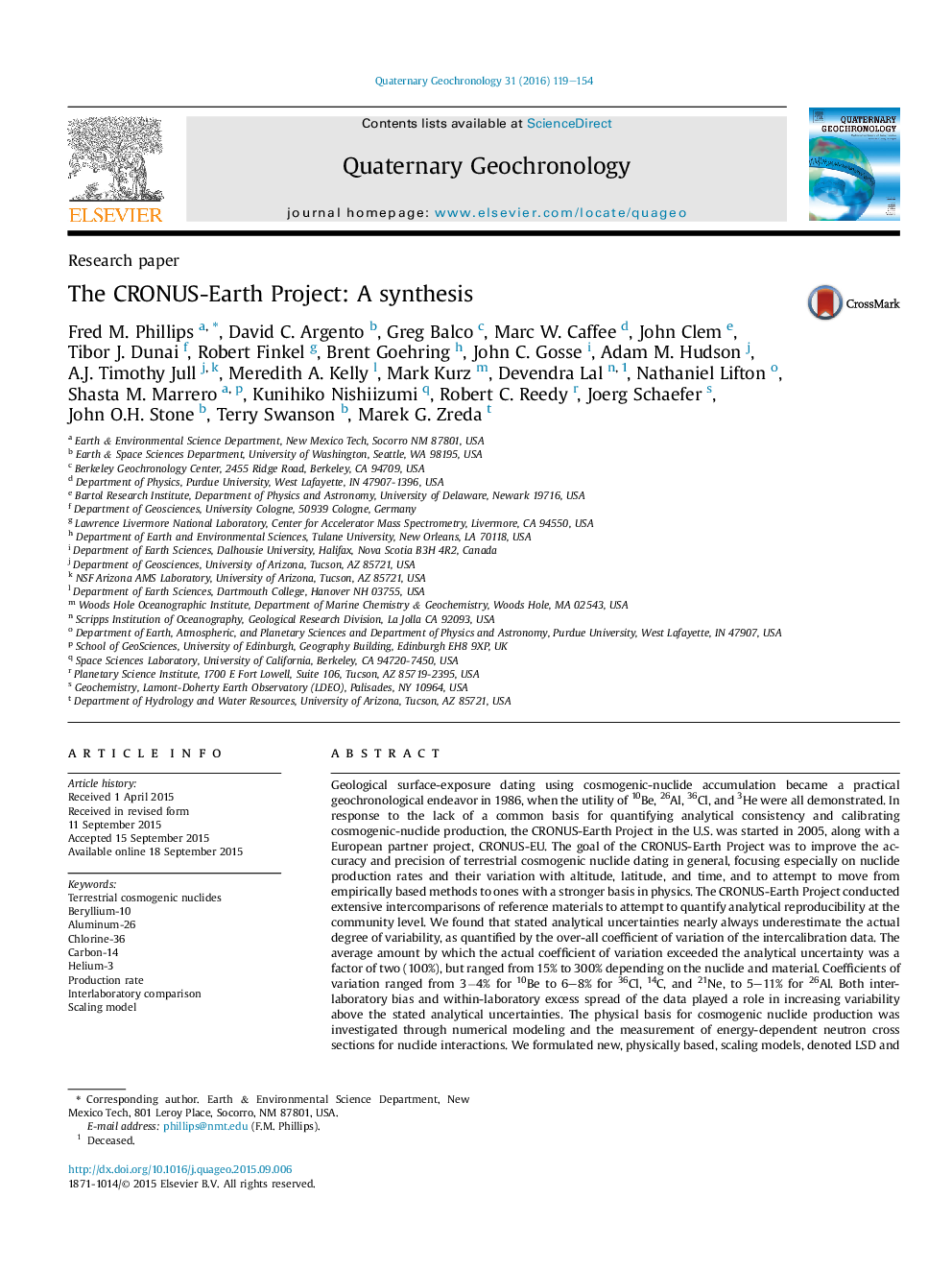| کد مقاله | کد نشریه | سال انتشار | مقاله انگلیسی | نسخه تمام متن |
|---|---|---|---|---|
| 6442516 | 1639845 | 2016 | 36 صفحه PDF | دانلود رایگان |
عنوان انگلیسی مقاله ISI
The CRONUS-Earth Project: A synthesis
دانلود مقاله + سفارش ترجمه
دانلود مقاله ISI انگلیسی
رایگان برای ایرانیان
کلمات کلیدی
موضوعات مرتبط
مهندسی و علوم پایه
علوم زمین و سیارات
ژئوشیمی و پترولوژی
پیش نمایش صفحه اول مقاله

چکیده انگلیسی
Geological surface-exposure dating using cosmogenic-nuclide accumulation became a practical geochronological endeavor in 1986, when the utility of 10Be, 26Al, 36Cl, and 3He were all demonstrated. In response to the lack of a common basis for quantifying analytical consistency and calibrating cosmogenic-nuclide production, the CRONUS-Earth Project in the U.S. was started in 2005, along with a European partner project, CRONUS-EU. The goal of the CRONUS-Earth Project was to improve the accuracy and precision of terrestrial cosmogenic nuclide dating in general, focusing especially on nuclide production rates and their variation with altitude, latitude, and time, and to attempt to move from empirically based methods to ones with a stronger basis in physics. The CRONUS-Earth Project conducted extensive intercomparisons of reference materials to attempt to quantify analytical reproducibility at the community level. We found that stated analytical uncertainties nearly always underestimate the actual degree of variability, as quantified by the over-all coefficient of variation of the intercalibration data. The average amount by which the actual coefficient of variation exceeded the analytical uncertainty was a factor of two (100%), but ranged from 15% to 300% depending on the nuclide and material. Coefficients of variation ranged from 3â4% for 10Be to 6-8% for 36Cl, 14C, and 21Ne, to 5-11% for 26Al. Both interlaboratory bias and within-laboratory excess spread of the data played a role in increasing variability above the stated analytical uncertainties. The physical basis for cosmogenic nuclide production was investigated through numerical modeling and the measurement of energy-dependent neutron cross sections for nuclide interactions. We formulated new, physically based, scaling models, denoted LSD and LSDn, by generalizing global numerical simulations of cosmic-ray processes. The CRONUS-Earth Project identified new geological calibration sites, including one at low latitude and high elevation (Huancané, Peru), and replicated nuclide measurement at numerous laboratories. At many sites multiple nuclides were measured, providing much more confidence in the equivalence of surface-exposure ages calculated from differing nuclides. The data were interpreted using an original cosmogenic-nuclide calculator, CRONUScalc, that incorporates the new physically based scaling. The new data and model produced significantly better fits than previous efforts, but do not fully resolve apparent spatial variations in production rates. The CRONUS-Earth and CRONUS-EU Projects have provided a firm foundation for assessing the strengths and weaknesses of cosmogenic-nuclide analytical methods, adjusted the AMS standards for 10Be and consequently revised the half-life, and have provided improved calibration data sets and interpretative tools.
ناشر
Database: Elsevier - ScienceDirect (ساینس دایرکت)
Journal: Quaternary Geochronology - Volume 31, February 2016, Pages 119-154
Journal: Quaternary Geochronology - Volume 31, February 2016, Pages 119-154
نویسندگان
Fred M. Phillips, David C. Argento, Greg Balco, Marc W. Caffee, John Clem, Tibor J. Dunai, Robert Finkel, Brent Goehring, John C. Gosse, Adam M. Hudson, A.J. Timothy Jull, Meredith A. Kelly, Mark Kurz, Devendra Lal, Nathaniel Lifton, Shasta M. Marrero,